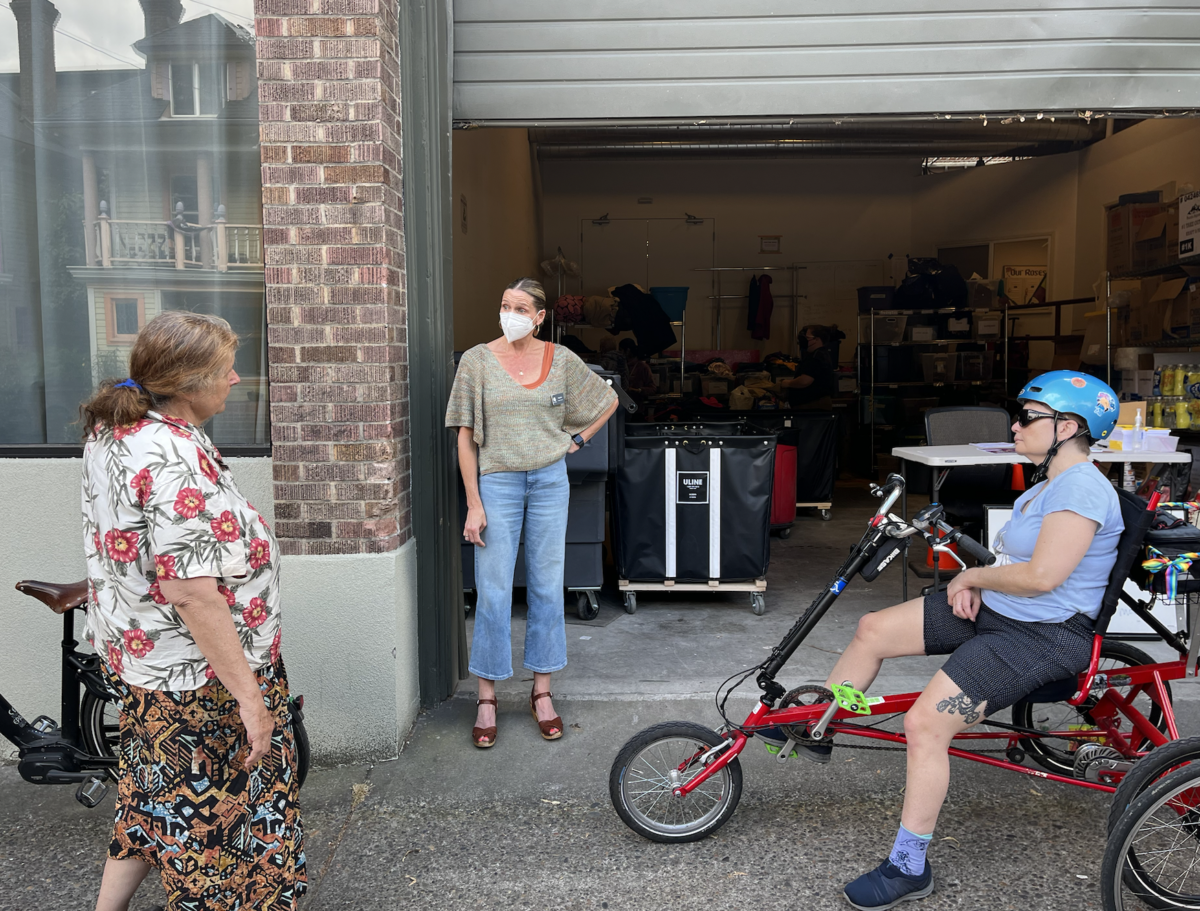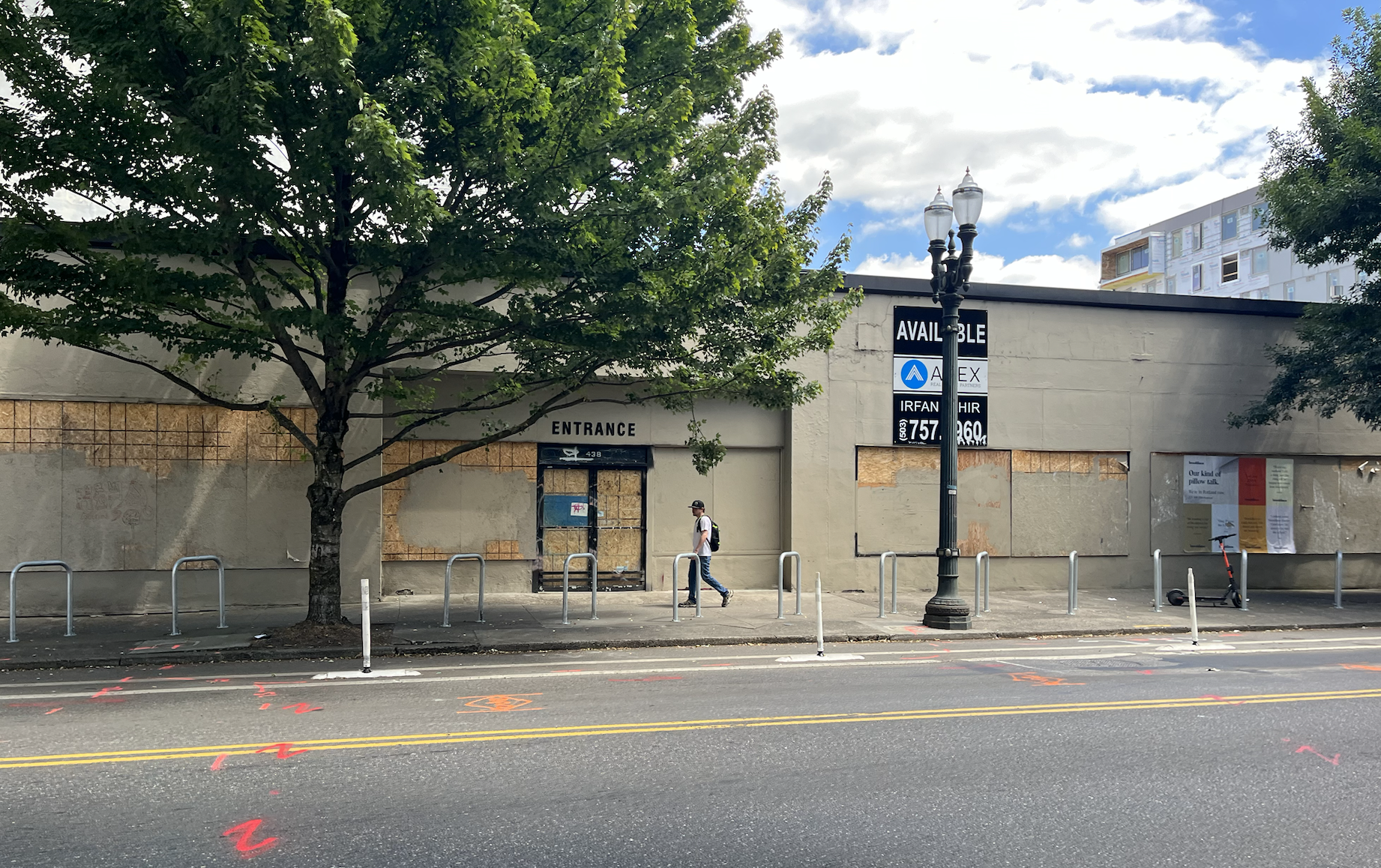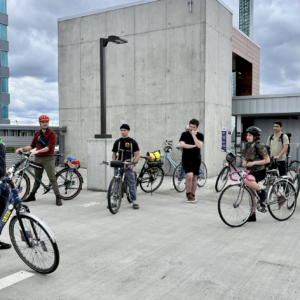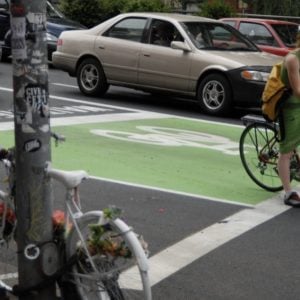
Most of the Bike Loud PDX Portland ‘policy rides’ Cathy Tuttle has led so far this year have focused specifically on bike or transportation policy. Last month, for instance, Tuttle recruited Portland Bureau of Transportation’s signals manager Peter Koonce to lead a tour of Central City traffic signals, and the month before, the Parking Reform Network’s Tony Jordan gave riders the lowdown on Portland parking policy.
This month, however, Tuttle went in a new direction and tackled a subject transportation activists aren’t always directly involved in: homelessness and social services. It’s not as cut and dry as a ride looking at bike signals, but Tuttle thought it was just as important to show bike advocates what’s going on in this sector of Portland life.
Tuttle told me she wanted to connect the themes of homelessness and access to social services with transportation advocacy or city planning generally because cities are made up of more than just inanimate physical infrastructure. The network of social services and people working together to help each other make up the fabric of downtown Portland just as much as bike lanes, the Streetcar and MAX rails do.
“People are part of the city,” Tuttle said.
Portland’s Old Town has been a favored place for people to set up camps because it’s a hub for resources that aren’t available in other parts of the city. This became especially pertinent during the pandemic, when many social service organizations around Portland had to restructure and couldn’t provide the same services as they used to. Over the last few years, unhoused people have formed communities in Old Town and become a part of the neighborhood. This has become a hot button issue for people across the ideological spectrum, with some people using the prevalence of tents downtown as a sign of Portland’s rapid decay – a thought process I don’t find conducive to progress and thoughtful city planning.
Bike Loud aims to make Portland accessible without a car, which means acknowledging there are many people in the city who don’t drive whose needs can be overlooked in favor of accommodating car drivers. This group of people includes many homeless people, who – like all of us – should be able to access things they need without traveling very far.


This is why it’s so painful for people when the city sweeps their camps and forces them to go elsewhere, cutting off access to services and a community they’ve grown familiar with.
Along with city-ordered encampment clean-ups, which have been revving up in Old Town in recent months, people living on the streets are subject to hostility from business and property owners. We rode past the unsanctioned bike racks erected on NW Broadway outside a building owned by Schnitzer Properties, which homeless advocates saw as hostile architecture intended to prevent people from setting up tents on the sidewalk (there isn’t demand for bike parking on that block). In contrast, PBOT’s new car-free plaza in Old Town, which we took a quick look at, provides a welcoming space for the public to enjoy. This is an example of how infrastructure can determine who is allowed to exist in a city – how public ‘public space’ really is.
At Rose Haven, an organization in the Northwest District a bit outside Old Town that serves women and children as a community center and day shelter, people who need some help getting around the city can get financial assistance for TriMet passes. They have a designated transportation assistance budget, which just shows how important transportation access is.
We spoke to people from Stone Soup and Sisters of the Road, both organizations that give people a chance to work in food service, which helps people with career training and allows for community connection. We also rode past service providers like Transition Projects, Blanchett House and a day storage facility, as well as P:ear, a program that offers homeless youth the very cool opportunity to learn professional skills including bike repair. Looking at all the programs that exist within about a 1.5 mile radius, I thought it was meaningful that all of them serve to fill some gap. People are in communication with one another, working together to ensure they’re able to serve the community the best they can.
“One organization can’t do it all,” said Lana Silsbe, the kitchen manager at Sisters of the Road. “We rely on everyone; we work together.”







Thanks for reading.
BikePortland has served this community with independent community journalism since 2005. We rely on subscriptions from readers like you to survive. Your financial support is vital in keeping this valuable resource alive and well.
Please subscribe today to strengthen and expand our work.
Why is it that this city depends on a constellation of private public-benefit corporations to provide services that are a basic human right?
Is this city so conservative that it refuses to allow government to provide essential services to Portland residents?
In a similar vein, is this city so libertarian that it categorically opposes growing the size of our government in order to meet basic human needs?
Lobbying by the homeless-service industrial complex? It does seem like these services would be better and cheaper if they were part of a city bureau. Did I just say that?
I ask myself this constantly. I’m all for non-profits. But if the existence of a non-profit is contingent on government money, and if the provision of city service is contingent on having a non-profit do it, then it should just be done by an appropriately staffed city agency. Portland’s government, as it currently functions, is allergic to state capacity and continues to embrace a very neoliberal service structure.
I think what matters is whether the services are provided, and are provided effectively and efficiently. We’ve all heard of both government agencies and nonprofits that do a bad job. Why do we care whether it is done one way or the other?
One benefit of using nonprofits is that it’s relatively easy to fire them if they do a bad job.
A disadvantage of using nonprofits is a likely lack of coordination and duplication of services.
So I think the focus of government should be organizing what’s already being done, identifying what needs to be done, and growing either the government or the nonprofit sector to address the gaps.
This city has definitely gotten more conservative, and more Libertarian since I moved here.
And as poor people, lower-income-working class people, and lower-middle class people continue to be evaporated from the urban center it will almost certainly continue to become ever more conservative and libertarian.
The housing crisis, not the fake upper-class housing crisis of YIMBYs*, is at the root of just about every regressive trend in this sorry excuse for a city.
*The YIMBY housing crisis is mostly about the dearth of “nice” housing for economically-comfortable university-educated white people who are in the upper classes or on a trajectory that will land them in the upper classes.
Awesome ride, Cathy! Sad I missed it.
It really strikes me the idea that social infrastructure is also a part of the infrastructure that creates a car-free society.
It’s easy to see bike lanes, transit-only lanes, and signals that benefit car-free modes of travel. Or even car-free developments oriented to them.
But the harder pieces of the car-free puzzle to see are the social services that already serve primarily individuals without a car. Most often these folks can’t afford a car and aren’t exactly centered in advocacy discussions. Great piece!
One of the places we visited on this tour, Stone Soup, does a training program for people who live in secure housing who want to get jobs in the food industry. According to Stone Soup’s director, of the 65 people who’ve gone through the program in the past few years, only two owned a car. People who work long hours, have secure housing, and need to travel are who we need to be planning our future sustainable, equitable transportation system (and housing) for.
It isn’t just our unhoused neighbors who cannot afford to own and maintain a car who need safe, frequent, and reliable walk, bike share, and transit. 40% of Portlanders are too young, too old, just getting by, or lack the physical ability to own a car. And yet we continue to invest the majority of our money and staff in streets, freeways, and bridges for people who drive.
The picture shows the sidewalk being used by a pedestrian, however, which wouldn’t have been possible if it’d been blocked by tents.
And any bike parked in that location would be stolen in a New York minute.